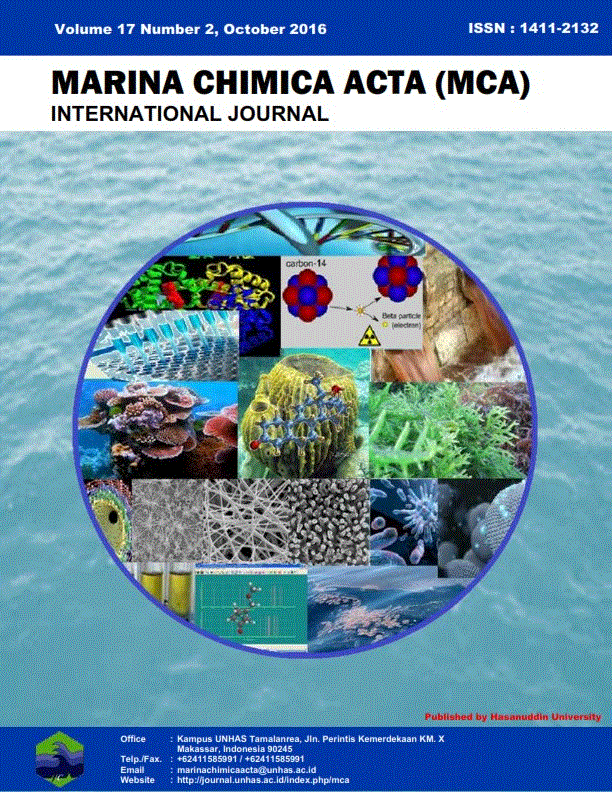ANALYSIS MINERAL ESSENTIAL (CRHOMIUM, ZINC AND MANGAN) AND BIO-PHYSICAL CHEMISTRY TEST AT HOME HONEY DISTRICTS KINDANG BULUKUMBA
Abstract
Honey is a sweet liquid that comes from the nectar of plants that are processed by bee. The composition of minerals in honey is an important factor in determining the quality of honey because it can affect the properties of bio-chemical physics honey. This research investigated the essential minerals concentration (Cr, Zn, and Mn), as well as the properties of bio-chemical physics. Three samples were collected from different location in the district Kindang is, Kindang, Pattallassang and Oro Gading. Honey samples were analyzed for essential micro mineral Chromium, Zinc and Manganese by using instrument ICP-OES and also analyzed for common bio-physicochemical parameters like moisture content, acidity, ash, pH, conductivity, protein, fat, carbohydrate and calorie. Ranged concentration manganese content of honey from 0.05 to 0.07 mg/mL0,05-0,07 mg/mL and concentration of chromium ≤0,1 ng/mL-0.22 mg/mL, whereas the concentration of zinc is below the limit detection tool that is ≤0,1 ng/mL. The average value of the quality of honey Kindang districts is 19.69% water content, ash content of 0.26%; DHL 0.36 mS/cm; 22.06 acidity meq/kg; pH 4.43; protein of 7.19% (w/w); 0.1301% fat. Total carbohydrate is 72.55%; calories 320.3101 cal; and energy 1340.2289 KJ. The results of this study indicate that manganese has the highest concentration in all samples of honey and showed tah hhoney from Kindang district have the a good quality according to national and international standar of honeyReferences
Badan Standarisasi Nasional Indonesia, 2004, SNI- 01-3545-2004: Madu, Badan Standarisasi Nasional Indonesia, Jakarta.
Bogdanov, S., and Ggallman, P., 2008, Authenticity of Honey Bee and Other Bee Products State of the Art, Swiss.
Bogdanov, S., 2009, Harmonised Methods of the International Honey
Commission, World Network of Honey Science, Switzerland.
Buba, F., Gidadio, A., dan Shugab, A., 2013, Analysis of Biochemical Composition of Honey Bee Samples from Nort-East Nigeria, Biochemistry Anal Biochem, 2 (3); 1-7.
Cahyani, D.I., 2015, Pengaruh Penambahan The Hijau terhadap Aktivitas Antioksidan dan Kadar Protein Minuman Funggsional Susu Kedelai dan Madu, Skripsi, Program Studi Ilmu Gizi Fakultas Kedokteran Universitas Dionegoro, Semarang.
Conti, M. E., 2000. Lazio Region (Central Italy) Honeys: A Survey of Mineral Content and Typical Quality Parameters. Food Control, 11 (1); 459–463.
Conti, M. E., Finoia, M. G., Fontana, L., Mele, G., Botrè, F., dan Lavicoli, I., 2014, Characterization of Argentine Honeys on the Basis of their Mineral Content and Some Typical Quality Parameters, Chemistry Central J., 8 (44); 1-10.
David, L., Watts, D.C., and Ph, D., 1988, The Nutritional of Realtionship of Zinc, Journal of Orthomoleculer Medicine, 3 (2); 63-67.
Eremia, N., Dabija, T., and Dodon, I., 2010, Micro and Macroelements Content in Soil, Plants Nectaro Pollenifer Leaves, Pollen and Bees Body, Scientific Papers: Animal Science and Biotechnologies, 43 (2); 180-182.
Fredes, C., dan Montenegro, G., 2006, Heavy Metals And Other Trace Elements Contents In Chilean Honey, Ciencia e Investigacion Agraria, 33 (1);50-58.
Hardman, R., 2014, Honey In Traditional and Modern Medicine, CRC Press, London.
Harjo, S.S.T., Radiati, L.E., dan Rosyidi, D., 2004, Perbandingan Madu Karet dan Madu Rambutan Berdasarkan Kadar Air, Aktivitas Enzim Diastase dan Hidroximetifurfural, Universitas Brawijaya, Malang.
Hikmawaty., 2015, Mineral Esensial (Co, Ni dan V) Serta Sifat Bio-Fisika Kimia Pada Madu asal Mallawa Sulawesi-Selatan, Skripsi, Jurusan Kimia FMIPA Unhas, Makassar.
Khan, Z., F., Saif-ur-Rehman, dan Maqbool T., 2008. Physical and Spectroscopic Characterization of Pakistani Honey. Ciencia e Investigacion Agraria, 35 (2); 199-204.
Karim, F. F., Noor, A., dan Natsir, H., 2015, Analisis Mineral Esensial (Vanadium, Kobalt dan Nikel) dan Uji Bio-Fisika Kimia pada Madu asal Desa Terasa Sinjai, Jurusan Kimia FMIPA Universitas Hasanuddin, Makassar.
Lachman, J., Kolihová, D., Miholová, D., Kosăta, J., Titĕra, D., and Kult, K. 2007. Analysis
of minority honey components: Possible use for the evaluation of honey quality. Food Chem 101; 973–979.
Libertato, et all., 2013, Physicochemical properties and mineral and protein content of honey samples from Ceará State, Northeastern Brazil, Food Science and Technology, 33 (1); 38-46.
Manzoor, M., Mathivanan, V., Shah, G. H. N., Mir, G. M., dan Selvisabhanayakam, 2013, Physico-Chemical Analysis of Honey of Apis
Cerana Indica and Apis Mellifera from Different Regions of Anantnag District, Jammu & Kashmir, International J. of Pharmacy and Pharmaceutical Sciences, 5 (3); 635-638.
Maryland, D., 2005, Honey Bee Nutrition, MAAREC Publication, Pensylvania.
Patong, R., 2013, Analisis Kimia Pangan, Dua Satu Press, Makassar.
Ronen, E., 2007, Micro Elements in Agrculture, Partcial Hydroponics and Greenhouse, Israel.
Schulman, R. A., 2006, Solve it With Supplements, Recycled Paper, America.
Somorville, D., 2000, Honey Bee Nutrition and Supplementary Feeding, NSW Agriculture, Wales.
Sumarsih, S., 2003, Mikrobiologi Dasar, Upn Veteran, Yogyakarta.

